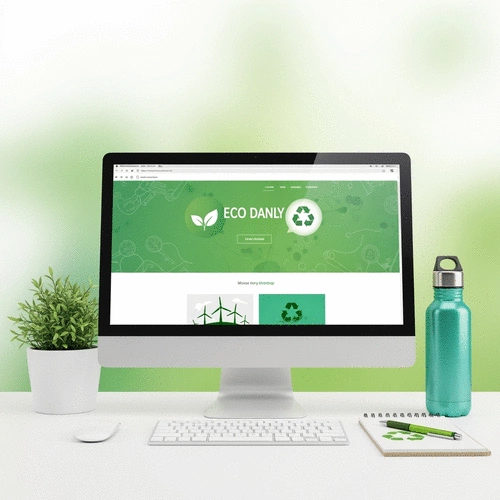What if your website could contribute positively to the environment while enhancing user experience? As digital sustainability becomes more crucial, embracing sustainable web design is no longer just an option but a necessity for forward-thinking businesses.
What You Will Learn
- Understand the core principles of sustainable web design, including efficiency, longevity, accessibility, and responsibility.
- Learn how reducing your website's carbon footprint aligns with consumer expectations and regulatory pressures.
- Discover how to integrate Sustainable Development Goals (SDGs) into your web design practices for greater impact.
- Gain insights on aligning your business strategy with environmental responsibility to appeal to eco-conscious consumers.
- Stay ahead of emerging trends in digital sustainability, including energy-efficient websites and green certifications.
- Explore the role of cloud computing in enhancing sustainable practices and reducing operational carbon footprints.
Sustainable Web Design Principles and Their Impact
This visual outlines the core principles of sustainable web design and their alignment with global sustainability goals and business benefits.
Core Principles of Sustainable Web Design
- Efficiency: Minimize resource use
- Longevity: Design for lasting impact
- Accessibility: Usable for everyone
- Responsibility: Acknowledge digital impact
Why Carbon Footprint Reduction Matters
- Consumer Expectations: Attract eco-conscious customers
- Regulatory Pressure: Meet growing government standards
- Cost Efficiency: Reduce operational costs long-term
Alignment with UN Sustainable Development Goals (SDGs)
- Goal 12: Responsible Consumption & Production
- Goal 13: Climate Action
- Goal 9: Industry, Innovation & Infrastructure
Role of Cloud Computing in Sustainability
- Efficient resource utilization
- Often powered by renewable energy
- Scalability reduces excess hardware
Understanding Sustainable Web Design and Its Importance
At Web Designer Near Me Digest, we believe that understanding sustainable web design is crucial for businesses aiming to make a positive impact. Sustainable web design involves creating websites that are not only user-friendly but also environmentally responsible. This approach focuses on minimizing the carbon footprint and promoting eco-friendly practices throughout the design process.
By prioritizing sustainability, we can create a more responsible online presence that resonates with environmentally-conscious users. This not only enhances the user experience but also aligns with the growing demand for businesses to take proactive steps toward environmental stewardship.
Defining Sustainable Web Design and Its Core Principles
Sustainable web design is about integrating environmental considerations into the web development process. Here are the core principles that guide this approach:
- Efficiency: Minimizing resource use, such as bandwidth and energy consumption.
- Longevity: Designing websites that are built to last, reducing the need for frequent redesigns.
- Accessibility: Ensuring that websites are usable for everyone, regardless of their abilities.
- Responsibility: Acknowledging the impact of digital products on the environment and making informed choices.
For a deeper dive into these principles and the latest updates in sustainable web design models, you can refer to insights from The Green Web Foundation. By following these principles, we can help create a web environment that is not only functional but also contributes positively to the planet. Have you ever considered how your website’s design choices can affect sustainability?
Why Carbon Footprint Reduction Matters for Businesses
Reducing the carbon footprint of your website is more than just a trend; it’s a responsibility. By implementing sustainable web design practices, businesses can significantly lower their environmental impact. Here are a few compelling reasons why this matters:
- Consumer Expectations: More consumers are choosing brands based on their environmental commitment.
- Regulatory Pressure: Governments are increasingly implementing regulations that encourage sustainability.
- Cost Efficiency: Sustainable practices often lead to reduced operational costs over time.
It's essential to understand that every small change contributes to a larger cause. When we take steps to reduce our carbon footprint, we’re making a statement about our values and priorities as a business. You can learn more about estimating digital emissions and their impact on the environment.
Aligning Sustainable Web Design with Sustainable Development Goals (SDGs)
At Web Designer Near Me Digest, we recognize the importance of aligning our practices with the Sustainable Development Goals (SDGs). These goals, established by the United Nations, provide a framework for a sustainable future. Here are a few specific goals related to sustainable web design:
- Goal 12: Responsible Consumption and Production - Encouraging efficient resource use.
- Goal 13: Climate Action - Taking urgent measures to address climate change.
- Goal 9: Industry, Innovation, and Infrastructure - Building resilient infrastructure that promotes sustainable industrialization.
By integrating these goals into our web design practices, we enhance not only our business's credibility but also contribute to a wider community effort in promoting sustainability. How can your website embody these principles and inspire others to follow suit? Further research on the connection between sustainable web design and SDGs can provide valuable insights.
Pro Tip
When designing your website with sustainability in mind, consider implementing a content delivery network (CDN). A CDN can significantly reduce the energy consumption associated with data transfer by caching your content closer to users. This not only speeds up load times but also minimizes your website's carbon footprint!
Embracing Sustainable Web Design for Future Success
At Web Designer Near Me Digest, we believe that integrating sustainable web design into your business strategy is not just a trend—it's essential for long-term success! As we look ahead, it's vital to align your operations with environmental responsibility. This alignment not only strengthens your business but also appeals to a growing number of eco-conscious consumers.
Consider how your website can reflect your commitment to the planet. By embracing sustainable practices, you create a brand image that resonates with customers who prioritize sustainability. It’s a win-win situation where your business thrives while contributing to the well-being of our environment!
Aligning Business Strategy with Environmental Responsibility
To truly make an impact, your business strategy should intertwine with environmental responsibility. Here are some steps to consider:
- Assess your current practices and identify areas for improvement.
- Set clear sustainability goals that align with your overall business objectives.
- Involve your team in brainstorming sessions to foster a culture of sustainability.
- Evaluate and choose sustainable web design solutions that suit your brand.
- Monitor progress and report outcomes to stakeholders regularly.
By making these adjustments, you'll not only enhance your brand's reputation but also contribute positively to the environment. Let’s face it—standing out in today’s competitive market means showcasing your commitment to sustainability!
Preparing for Future Trends in Digital Sustainability
The digital landscape is continually evolving, and so are the expectations for sustainability. As we enter a new era of digital sustainability, it's important to stay ahead of the curve. Here are some trends to watch out for:
- Increased demand for energy-efficient websites that consume less power.
- Emergence of new tools for measuring website carbon footprints.
- Shift towards cloud computing as a standard for hosting eco-friendly websites.
- Growing interest in green certifications among businesses.
By preparing for these trends, you can ensure that your business stays relevant while contributing to a sustainable future. I can't stress enough how crucial it is to adapt and evolve!
Understanding the Role of Cloud Computing in Sustainable Practices
Cloud computing has revolutionized the way we store and manage data, and it also plays a pivotal role in sustainable web design. Here’s why:
- Cloud services often utilize resources more efficiently than traditional hosting methods.
- They typically employ renewable energy sources to power their data centers.
- Cloud solutions enable scalability, minimizing the need for excess hardware.
By leveraging cloud computing, your business can significantly reduce its carbon footprint while enhancing performance. This forward-thinking approach not only benefits your operations but also impresses eco-conscious customers!
Frequently Asked Questions (FAQs)
What is sustainable web design?
Sustainable web design involves creating websites that are environmentally responsible, focusing on minimizing their carbon footprint and promoting eco-friendly practices throughout the design and development process. Its core principles include efficiency, longevity, accessibility, and responsibility.
Why is reducing a website's carbon footprint important for businesses?
Reducing a website's carbon footprint is important because it aligns with growing consumer expectations for environmental commitment, helps businesses meet increasing regulatory pressures for sustainability, and can lead to long-term cost efficiencies through optimized resource use.
How does sustainable web design align with the UN Sustainable Development Goals (SDGs)?
Sustainable web design aligns with SDGs like Goal 12 (Responsible Consumption and Production) by encouraging efficient resource use, Goal 13 (Climate Action) by addressing digital emissions, and Goal 9 (Industry, Innovation, and Infrastructure) by building resilient and sustainable digital infrastructure.
What role does cloud computing play in sustainable web design?
Cloud computing contributes to sustainable web design by offering efficient resource utilization, often powering data centers with renewable energy, and providing scalability that reduces the need for excess hardware, thereby lowering a website's carbon footprint.
What are some future trends in digital sustainability?
Future trends in digital sustainability include an increased demand for energy-efficient websites, the emergence of advanced tools for measuring website carbon footprints, a broader shift towards cloud computing for eco-friendly hosting, and a growing interest in green certifications for digital products and services.
Recap of Key Points
Here is a quick recap of the important points discussed in the article:
- Sustainable Web Design: Focuses on minimizing carbon footprint while enhancing user experience.
- Core Principles: Efficiency, longevity, accessibility, and responsibility are key to sustainable practices.
- Consumer Expectations: Businesses are increasingly expected to demonstrate their commitment to sustainability.
- Aligning with SDGs: Integrating Sustainable Development Goals helps in promoting responsible consumption and climate action.
- Future Trends: Stay ahead by preparing for energy-efficient websites and cloud computing solutions that support sustainability.









